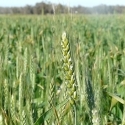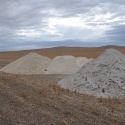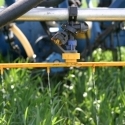08 Apr 2010
Sulphur for canola in 2010
Canola growers are advised to check to make sure S does not limit yields in 2010
With a good start to the 2010 season and some stored water in the soil profile, it is likely that canola will feature on the cropping program of grain producers again. While most growers would have planned to meet the N demand for their crop, Dr Rob Norton, IPNI Regional Director based in Horsham, would remind them that sulfur is a often overlooked as a critical nutrient for this crop.
Sulfur deficiency has become more common now that single superphosphate (11% S) is rarely used. Canola has a high S demand so it will show up this deficiency first. Wheat removed about 1.5 kg S per tonne of grain, while canola has around 7 times that concentration. Symptoms are seen as yellowing of leaves while the veins remain pale green and reddening under the leaves. Flowers are pale rather than bright yellow.
High rates of N will also induce an S deficiency as the sulfur is often the next more limiting nutrient. For canola in Canada, growers use a 7:1 N:S ratio for N:S supply as a guide to balanced fertilizer use.
Growers who have had soil tests can check the KCl-40 value, and if this is less than about 12 ppm, then additional S should be considered. At these soil test levels, S should be applied to at least balance the expected off-take of S in grain.
Sulfur exists in at least two fertilizer forms – elemental-S and sulfate-S. Elemental-S must be converted to sulfate S for plant uptake but this process can be slow and at least some S should be applied as sulfate-S.
There are several products that can be used to meet S requirements, such as ammonium sulfate, S fortified nitrogen urea, S fortified MAP, superphosphate and gypsum. In 2009 experiments in the Mallee and Wimmera, good quality gypsum was less effective than ammonium sulfate on canola which may be due to the placement of the nutrients and/or the acidifying effect of ammonium sulfate on the soil.
Topdressing during vegetative growth with sulfate-S can also be effective in meeting S demand by the crop.
For More Information see Hocking P, RM Norton, A Good (1999). “Canola nutrition.”, In Canola in Australia – the first thirty years. (Eds PA Salisbury, TD Potter, G McDonald, AG Green). (Organising Committee for the Tenth International Rapeseed Congress, Canberra). p. 15-22
(http://www.australianoilseeds.com/__data/assets/pdf_file/0013/2704/Chapter_4_-_Canola_Nutrition.pdf)
Additional Resources
BC sulfur and canola.pdfSize: 0.03 MB




